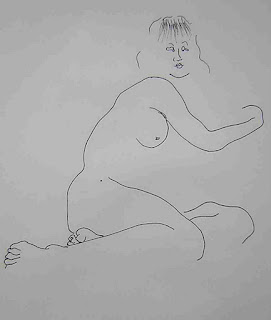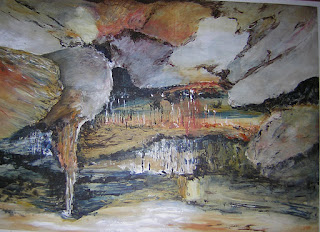 |
View from the Australian Archaeological Hostel, Athens.
Coloured pencil, Peter Kreet.
|
The first night I spent in the Plaka district of Athens several years ago, I wrote what one could call a pose/poem.
Sound of a cat's wail and hiss at dawn,
dogs bark amongst
the sound of rumbling garbage trucks welcome dawn.
Laying in bed, listening,
to bottles roll across the cobble stones,
broken glass mixed with night's memories.
Lets' spend another evening within the district's embrace.
Standing at the window, watching dawn's fingers
marble the Attic sky
unchanged in their slow dance across time,
since Homer first cast their part
a thousand years, no two, three have passed.
Mingled voices raise from street below,
then melt into the soft drone of
an engine as it slowly edges across the city.
Light grows sharper, voices stronger,
loud motor cycles punch the soft warm air
to jolt memory towards other thoughts.
Athens has a presence that must be felt to be understood.
 |
Plaka, old Turkish Quarter of Athens.
Watercolour sketch. Peter Kreet |
Athens is not everyones' idea of an ideal city, but with such a history and mythology it is hard for any visitor not to be moved. Captured by the Ottoman Turks in 1456, four hundred years passed before the skies cleared. On independence it was little more than a country town, its Acropolis in ruins, it required knowledge of the past to hope for a better future. The Plaka is the oldest part of Athens, the old Turkish quarter.at the foot of the Acropolis. Despite the tourists ,the Plaka offers the visitor a lot in atmosphere and history. As recently as the 1970s , its' cafes and bars offered refuge to students during the rule of the Generals. All had secret exists at their rear to allow escape in the event of a police raid. I always make a point of visiting some to hear rebetica music in these establishments, the bouzouki music of protest and sorry made famous during those times by Theodorakis and other composers. Music that the Asia-Minor Greeks brought with them from Smyrna's nightclubs with their repertory of songs about hashish-dens, gambling, prostitution, theft etc. This bouzouki music was given fresh life in the 60's and 70's, Maria Farantouri was in full flight along with many young composers. These songs rallied the students and Greeks in general to resist the torture and disappearances of so many during these dark times.
Athens is full of contradictions, its modern population arrived after the First World War ,in 1922/3 when the Greek population of Turkey was exchanged for the Turks still living in Greece. The result is a rather ugly modern city over laid on an ancient one. Houses were needed in a hurry. Still there is the Acropolis and many fine museums specialising in Antiquity. You may stroll along the Agora, where Socrates corrupted the city's youth, rebuilt by the Americans and now used as a study centre. The patterned shadows at certain times of the day create works of art on the marble floor.
 |
Agora, Athens [ ancient market]
|
Between my drawing trips around the city I would discover many interesting dens and galleries. One that particularly took my fancy was called The Centre for Hellenic Tradition on Pandrossos Street, Plaka, a Greek version of an Irish Pub. The owner had taken upon himself the responsibility to save the traditions and folk art of the Greek Island before they were swept away by the tide of modern day tourism. Musician would drop in at anytime of the day and play bouzouki music, some would sing. Various groups would take turns at performing, while many patrons of the establishment would dance among the tables. It was a great atmosphere, drinking strong local wine or ouzo and eating traditional snacks. The music was very impromptu and seemed to drift up into the air in the manner of a column of smoke, not unlike Zen mediation music, just a single note moving through space.
I used to stay at the Australian Archaeological Institute at Athens hostel, a voluntary organisation that funded archaeology digs and scholarships to Australian students interested in the ancient world. Anyone living in Australia may join for a small annual fee and use the hostel when ever they visit Athens. At the time I was in Athens to meet up with Professor Alexander Cambitoglou ,who was responsible for the foundation of the Institute. At the time he was in charge of the Classics Department at Sydney University and had embarked on this most ambitious project. Australia had not been all that interested in the ancient world, no doubt they felt it was all too far away. On this evening we were going to dine at the Athenian Club a very conservative establishment. Unfortunately the only jacket i had with me was a leather one which proved to be too outrageous for the guardians. Still we found a very pleasant restaurant in a Plaka lane, one needed a guide to find it. The wall were covered with dozens of folk paintings from ever corner of the country and the food was some of the best I had found in Greece. It just shows that sometimes the impressive places are not always the best.
 |
Church of Ayioi Apostoloi, Athens. Peter Kreet.
This is the oldest Church in the city.
|
 |
Sheep's Heads. Archaeological Museum, Athens.
|
At times I would spend many hours looking at the Orthodox Icons in the many Churches. The Church of Ayioi Apostoloi has many fine examples, along with many other Churches. At other times I would draw the various exhibits in the museum. I have found this practice very beneficial over the years and the references and notes rewarding. My interest in the past has always been central to my life, as a child I was told that if you did not know where you had been, you could not possibly know where you are heading.
 |
| Peter Kreet. Plaka District, Athens. |


























































